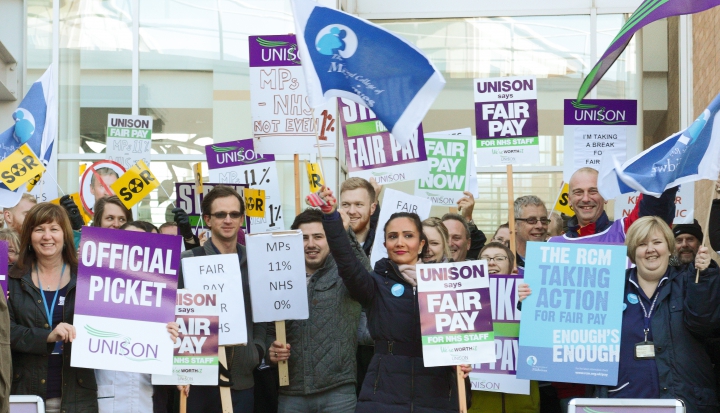When we think of labor unions, we often think of the millions of construction workers, truck drivers, hotel employees, nurses, and janitors employed by private firms across America who are represented by unions. We might also remember the millions of schoolteachers, trash haulers, police officers, and firefighters working who work for federal, state, and local government bodies who also belong to unions. But what about those who work for the Catholic Church?
The church in the United States, broadly conceived, is a major employer in its own right. Perhaps one million Americans work in Catholic hospitals, nursing homes, universities, grade schools, social service agencies, parishes, and diocesan offices. Only Wal-Mart and the U.S. government employ more workers!
Six years ago, Pope Benedict XVI boldly reaffirmed Catholic teaching on labor and labor unions in Caritas in Veritate. Rejecting arguments that labor unions were no longer needed under modern work conditions, the Holy Father contended that in our modern globalized economy “the repeated calls issued within the church’s social doctrine, beginning with Rerum Novarum, for the promotion of workers’ associations that can defend their rights must be honored today even more than in the past.” But what does this teaching imply for workers at Catholic institutions?
It seems self-evident that workers employed at Catholic institutions are entitled to the same rights—from a living wage to the right to form trade unions—that their counterparts working for secular firms enjoy. After all, the papal encyclicals don’t mention an exemption for Catholic institutions. And indeed, three decades ago America’s Catholic bishops connected the dots in their pastoral letter Economic Justice for All:
On the parish and diocesan level, through its agencies and institutions, the Church employs many people; it has investments; it has extensive properties for worship and mission. All the moral principles that govern the just operation of any economic endeavor apply to the Church and its agencies and institutions; indeed the Church should be exemplary…. We bishops commit ourselves to the principle that those who serve the Church—laity, clergy, and religious—should receive a sufficient livelihood and the social benefits provided by responsible employers in our nation…. All church institutions must also fully recognize the rights of employees to organize and bargain collectively with the institution through whatever association or organization they freely choose.
The bishops were drawing lessons from a turbulent decade in Catholic schools and hospitals. During the 1970s tens of thousands of teachers, nurses, and health care workers in Catholic institutions had flocked to join labor unions.
The movement was in no way unique to Catholic institutions. To the contrary; teachers and health care workers everywhere were organizing in those years. But the Catholic institutions were already undergoing a wrenching adjustment. For decades members of religious orders had performed this work, and their vows of poverty, chastity, and obedience subsidized the education of our children and the care of our sick. The lay men and women who now assumed their jobs, however dedicated, had families to support, and poverty wages were not suited to their station in life. The new employees, like their peers in the community hospitals and the public schools, joined unions in increasing numbers in order to secure a voice at work.
Suddenly the bishops, pastors, and principals found their faith tested in a new way. Church leaders had firmly defended American workers as they formed unions and sought living wage protections during the New Deal. But how would they react when the workers in question were their own employees?
Employers are seldom happy to see their workers organize. Suddenly, instead of dictating wages and working conditions, they must negotiate them. Wages and benefits will almost certainly rise, creating new economic challenges in a competitive marketplace. And managers usually feel a sense of personal rejection, that they must have done something wrong if their employees want a union.
Leaders of Catholic hospitals and schools are not immune to any of these emotions and concerns. Too often they have given in to them, fighting to prevent their lay employees from forming unions despite their clear right to do so under church teaching. Some have gone so far as to cite their Catholic identity as a reason to deny workers the right to organize, as some Catholic colleges and universities have recently done in order to resist organizing drives by their adjunct faculty.
Fortunately, many others have followed the lead of the bishops, seeking to evangelize the world by expressing their faith in exemplary respect for the rights of their workers. As director of the Catholic Employer Project, I study labor relations at Catholic institutions and I’m proud to report that I have identified more than 200 Catholic schools, hospitals, universities, social service agencies, and newspapers whose employees enjoy union representation.
The managers and workers of these institutions are dedicated to their mission—teaching our children, caring for our sick—and at the same time offer a model of mutually respectful employment relationships informed by Catholic social teaching. They are an example to contemplate and learn from.
Image: Flickr cc via Roger Blackwell













Add comment